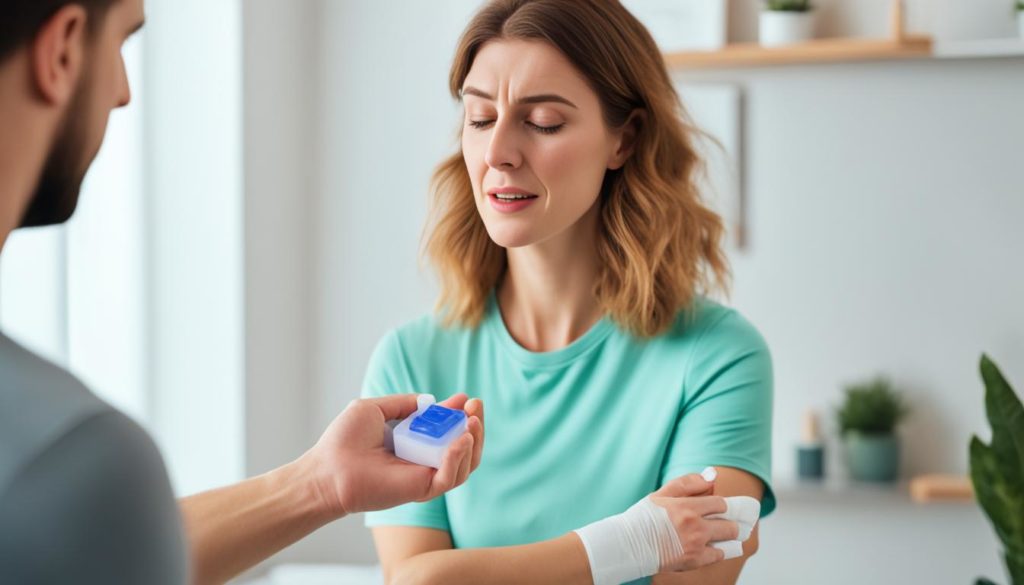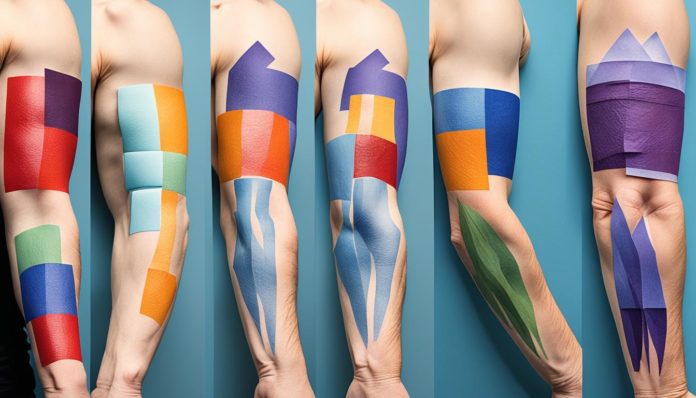Did you know nearly 80% of Americans get a significant bruise at least once? Bruises, or contusions, are very common. They can happen from minor incidents like hitting furniture to more active causes like sports. Learning to treat bruises well can lessen pain and speed up healing.
This guide gives you tips and remedies for bruises you can try at home. It covers immediate steps to take when you get a bruise, natural remedies, and the right foods for faster healing. We ensure you’re prepared to handle bruises effectively.
Key Takeaways
- Understanding the common causes behind bruises is crucial for effective treatment.
- Immediate actions such as applying ice packs and elevating the bruised area can significantly reduce swelling and pain.
- Home remedies, including Aloe Vera, Arnica, Bromelain, and Vitamin C, can speed up the recovery process.
- Topical treatments and proper nutrition play a vital role in bruise recovery.
- Various preventative measures and lifestyle adjustments can help minimize the likelihood of bruising in the first place.
Understanding What Causes Bruises
Bruises, or contusions, happen when tiny blood vessels under the skin get damaged. This leads to blood leaking out, causing discoloration and soreness. Learning about what causes bruising is key to managing and preventing it well.

The Science Behind Bruising
When an injury breaks capillaries without skin breach, blood moves into nearby tissues. This results in the black-and-blue marks of bruises. At first, a bruise looks red because of oxygen-rich fresh blood.
As oxygen reduces, it turns blue or purple. The body then processes hemoglobin, changing the bruise to green or yellow until it fades.
Common Activities That Lead to Bruising
Everyday actions can lead to bruising. High-impact sports, such as football or boxing, and accidents like tripping can cause them. Even minor bumps from daily tasks may result in bruises.
Age also plays a role in bruising; older people get bruises more easily because their skin is thinner and their blood vessels are more delicate. Knowing how bruises form and what causes them helps you avoid them, ensuring healthier skin and faster healing.
Immediate Actions to Take When You Get a Bruise
When you get a bruise, acting fast can really help. Quick treatment eases pain and can make the bruise less severe. Here’s what you should do:
Applying Ice Packs
Using an ice pack right away is a top method for treating a bruise. Ice lowers swelling and numbs the pain. Wrap the ice in a cloth and put it on the bruise for 10-20 minutes. Do this every hour for the first day.

Elevating the Affected Area
Raising the bruised part above your heart is key. It cuts down blood flow to the injury, which lessens swelling. For example, if your leg is bruised, lift it on a pillow when you lie down.
Avoiding Further Trauma
To heal well, keep the bruise safe from more harm. Stay away from activities that might worsen it. Using protective padding if needed is a good idea. This way, the area can heal faster and better.
Home Remedies for Quickly Healing Bruises
Bruises can hurt in two ways: physically and emotionally. Luckily, there are many natural home remedies for bruises that help heal them fast. This section talks about safe and useful ways to treat bruises at home.
Aloe Vera
Aloe vera is famous for calming and fighting inflammation. It’s a top pick for bruise remedies. Putting fresh aloe vera gel on your bruise can lessen pain and swelling. This helps the bruise heal quicker.
Arnica
Arnica is a great choice for treating bruises at home. People have used this herb for years because it fights inflammation and boosts blood flow. Applying arnica cream or gel on bruises can make them heal faster.
Bromelain
Bromelain comes from pineapples and helps reduce swelling. Eating bromelain-rich foods or using it on your skin can help with bruise remedies. It works by breaking down proteins that keep fluids in tissues, leading to quicker healing.
Vitamin C
Vitamin C is essential for fixing skin and helping the immune system. Eating foods full of vitamin C like oranges, strawberries, and bell peppers can boost your home remedies for bruises. It makes blood vessels stronger and helps produce collagen, which heals the skin.
Topical Treatments for Bruise Recovery
Topical treatments are key in healing bruises faster. Many products like creams and gels are available. It’s important to know what’s in them to choose the right one.
Ingredients like retinol, vitamin K, and arnica help bruises fade. They boost skin healing and blood flow to the bruise. Let’s look at what each ingredient does:
- Retinol: A vitamin A form, retinol helps skin renew faster, making bruises heal sooner.
- Vitamin K: It helps with blood clotting and speeds up healing by working on pooled blood under the skin.
- Arnica: An herb that lessens swelling and redness, making bruises less noticeable.
Using these treatments correctly is important. Massage them in gently 2-3 times a day. Always follow the product’s instructions.
Check out this table for some popular bruise treatments:
| Product | Key Ingredients | Recommended Usage |
|---|---|---|
| Neosporin LT | Retinol | 2-3 times daily |
| Koji White Kojic Acid Vitamin C Soap | Vitamin K | 2 times daily |
| Boiron Arnicare Gel | Arnica Montana | 3 times daily |
Picking the right product depends on your bruise and skin type. With the right treatment, healing can be fast and effective.
Nutrition and Supplements for Bruise Healing
Eating right plays a big part in how fast bruises heal. Knowing which vitamins and foods help can speed up your body’s recovery. Adding specific supplements for bruise healing into your diet boosts skin health and makes bruises disappear faster.
Important Vitamins for Skin Health
Some vitamins are key for healthy skin. Vitamin C boosts collagen, making skin and blood vessels stronger. Vitamin K helps blood clot and stops bruises from forming. Bioflavonoids make Vitamin C work better and keep blood vessel walls strong.
- Vitamin C: Found in citrus fruits, strawberries, and bell peppers.
- Vitamin K: Present in leafy greens such as spinach and kale.
- Bioflavonoids: Abundant in citrus fruits and dark chocolate.
Foods That Promote Healing
Eating well helps heal bruises faster. Foods good for healing aren’t just those high in Vitamin C and K. They also include ones rich in iron and zinc.
For better nutrition when dealing with bruises, try eating more of these:
- Iron-Rich Foods: Red meat, lentils, and dark leafy greens.
- Zinc-Rich Foods: Shellfish, nuts, and seeds.
- Protein Sources: Eggs, chicken, and tofu. They help fix skin tissue.
| Vitamin | Key Benefit | Sources |
|---|---|---|
| Vitamin C | Collagen Production | Citrus fruits, strawberries, bell peppers |
| Vitamin K | Blood Clotting | Spinach, kale, broccoli |
| Bioflavonoids | Strengthen Capillaries | Citrus fruits, dark chocolate |
| Iron | Hemoglobin Production | Red meat, lentils, spinach |
| Zinc | Skin Repair | Shellfish, nuts, seeds |
Choosing the right foods ensures your body gets what it needs to heal bruises quickly. Using supplements strategically can also help speed up recovery.
Advice for Reducing Bruise Visibility
Minimizing the look of bruises is important for many. This is true especially when they show in clear spots. These tips, including makeup and physical therapy, can really help.
Using Makeup and Concealers
Concealing bruises with makeup is a top method. Start with a color corrector, like green, to cancel out bruise colors. Then, apply a matching foundation and set it with powder.
Check out brands like MAC Cosmetics and Dermablend for high-coverage options. Layering these helps the bruise blend with your skin tone. For more advice, see this helpful guide on speeding up bruise healing.
Physical Therapy Techniques
Physical therapy helps make bruises less visible by healing them faster. Exercises that boost circulation can clear up the bruise quicker.
Try light massage, stretching, and exercises for the bruise area to heal fast. These steps fix damaged vessels and reduce bruising. They also improve skin health, alongside makeup.
Below, a table lists the best physical therapy methods for healing bruises:
| Technique | Benefits | Examples |
|---|---|---|
| Massage | Improves blood flow, reduces stiffness | Gentle circular motions |
| Stretching | Enhances flexibility, relieves tension | Hamstring stretch, calf stretch |
| Specialized Movements | Targets specific areas, accelerates healing | Range of motion exercises |
Using makeup and physical therapy together can really reduce bruise visibility. For detailed tips, check Healthline’s advice on managing bruises.
When to Seek Medical Attention for Bruises
Recognizing when to seek medical help for bruises is key. Most bruises are okay and heal on their own, but some need a doctor’s look. This guide helps you know when to get checked for bruises, focusing on symptoms that could point to bigger health issues.
If you notice a bruise with excessive swelling, it’s time to get it checked. Swelling that doesn’t go away or gets worse might mean there’s a deeper issue, like a broken bone or serious tissue damage.
Intense pain that stays or gets worse is a reason to visit a doctor for your bruise. Any sharp, ongoing pain or discomfort that increases could mean there’s a serious problem needing a doctor’s review.
Also, if there’s warmth, redness, pus, or fever near your bruise, it might be an infection. Infections can get bad fast and cause big problems if not treated right away.
Bruises that pop up for no reason or keep happening in strange places could signal something more. Things like clotting issues, lack of certain nutrients, or even some cancers can show themselves through such bruising. It’s important to know when these signs mean you should see a doctor.
| Symptom | Possible Indication |
|---|---|
| Excessive Swelling | Deeper injury or fracture |
| Intense Pain | Severe tissue damage or other serious condition |
| Signs of Infection | Bacterial infection requiring prompt treatment |
| Unexplained Bruising | Possible underlying health condition |
Knowing these signs helps tell minor bruises from those needing a doctor’s attention. If unsure, it’s always good to check with a healthcare professional. They can give you advice and the care you need.
Preventative Measures to Avoid Bruises
Preventing bruises is better than treating them. There are many ways to lower your risk. By taking certain steps, you can lower your chances of getting painful, unsightly bruises. Let’s talk about how to avoid bruises by wearing protective gear and changing your lifestyle.
Protective Gear
When doing physical activities, wearing the right protective gear is key. It helps a lot whether you’re playing sports, working out, or doing hard labor. Protective gear like padded gloves, knee pads, and elbow guards keep you safe. Nike, Under Armour, and Adidas have great gear to help avoid getting hurt and bruised.
Lifestyle Adjustments
Making small lifestyle changes can really help prevent bruises. Start by making your home and work places safer. Remove tripping hazards, improve lighting, and add handrails if needed. Eating right, full of vitamins C and K, also strengthens your skin and blood vessels. This means you’ll bruise less. Also, drinking lots of water, exercising regularly, and avoiding risky activities protect against bruises.
Using these tips can lead to a life with fewer bruises. Changing how you live and protecting yourself correctly are important. They help in lowering the risk of getting bruises.
FAQ
How can I treat a bruise at home?
Treating a bruise at home is easy with a few steps. Use ice packs and keep the area up high. Avoid making it worse by protecting the spot. Aloe Vera, Arnica, Bromelain, and Vitamin C can also help. They make the bruise fade and heal quicker.
What causes bruises and why do they occur?
Bruises happen when small blood vessels under the skin break. This is because of an injury. The leaking blood causes a mark. They can happen from sports, accidents, or daily jobs.
What immediate steps should I take when I get a bruise?
Start by putting ice on it to lessen swelling. Lift up the bruised spot. And don’t hit it again or press on it too hard.
Are there any effective home remedies for bruise healing?
For sure, home remedies can speed up healing. Use Aloe Vera and Arnica for less inflammation. Bromelain helps with swelling, and Vitamin C fixes the skin. Try these at home to recover from bruises faster.
What topical treatments can help with bruise recovery?
Creams and gels with retinol, Vitamin K, and arnica are good for bruises. They make bruises go away sooner. Just follow how to use them correctly.
How does nutrition impact bruise healing?
Eating right helps heal bruises. Important vitamins are K, C, and bioflavonoids. They keep the skin healthy. Eating fruits, greens, and protein helps fix skin faster and lower bruising.
How can I reduce the visibility of my bruise?
Covering a bruise with makeup works well. Also, physical therapy might speed up healing. It helps make the bruise look better faster.
When should I seek medical attention for a bruise?
Go to a doctor if the bruise badly swells, hurts a lot, or looks infected. These could be signs of a bigger problem. A professional should check it.
What steps can I take to prevent bruises?
Use the right protective gear when doing risky activities. Changing small things in your daily life and habits can stop bruises before they happen.


